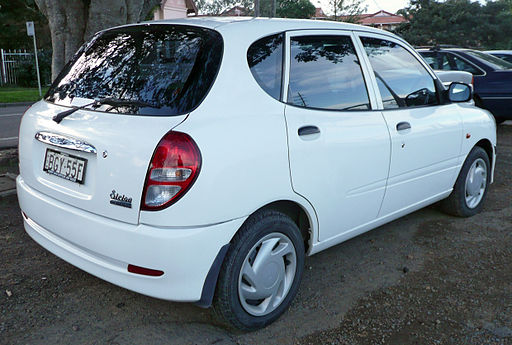The Hidden Costs of Not Owning a Car

The carless life: Is it for you?
Owning a car can be expensive: In addition to the cost of buying or leasing a vehicle, you have to pay for licenses, gas, insurance, upkeep, tolls, and parking. Many people, particularly city-dwellers, have decided to avoid the cost and hassle of owning a car and instead rely on walking, biking, public transit, and cabs to get around.
While not owning a car can save you a lot of money, there are also hidden costs to being car-free. Only after you've examined these costs should you make a decision about whether car ownership is in your best interest.
Please note: This post is not intended to sour you on having a car-free life. I've never even had a driver's license, much less owned a car. As with any consumer choice, you have to determine which choice makes the most sense for you and your family.
![By Oran Viriyincy from Bothell, WA, United States (GFI Genfare CENTSaBILL fare box, on Flickr) [CC BY-SA 2.0 (http://creativecommons.org/licenses/by-sa/2.0)], via Wikimedia Commons By Oran Viriyincy from Bothell, WA, United States (GFI Genfare CENTSaBILL fare box, on Flickr) [CC BY-SA 2.0 (http://creativecommons.org/licenses/by-sa/2.0)], via Wikimedia Commons](https://usercontent2.hubstatic.com/13116151.jpg)
Transportation fares
If you don't drive, you have a few options for getting around, including public transit, carpooling, cabs, rideshares, walking, cycling, and, for long distance trips, planes and trains. Some of these options cost a fair amount of money, so you'll need to run some numbers before deciding how much not having a car will save you:
- Public Transit Fares: Public transit fares vary by region, but a daily commute to and from work via train or bus can cost as much as $200 per month. While you may be eligible for tax savings on public transportation passes that you use to get to and from work, you'll still need to include these expenses in your monthly budget.
- Cab & Rideshare Fares: Cabs and rideshare services, such as Uber and Lyft, can be costly, and the fares aren't tax deductible for regular work commutes.
- Long Distance Travel: Road trips aren't possible if you don't have a car, so you may find that you need to fly or take a train to places that would otherwise be accessible via a relatively short drive. Travel to rural areas may be difficult, if not impossible, when there are no airports, cabs, rideshare, or public transit options available.
- Car Share and Car Rental Fees: In situations where you absolutely need a car, renting a car (or participating in a car share program) is an option, though costs can add up quickly.
Housing costs
Not having a car means that you'll have to live in a neighborhood that is close to public transportation options, public services (such as grocery stores), and where you can easily get around on foot. Rents and home values are often higher in areas where there is good public transit and access to services, so you may end up spending a lot more on a place to live.
If you don't drive and you need to find a new home, particularly in an unfamiliar area, allow yourself several weeks, even a month or more, to find a place. With determination and networking, you may be able to find an affordable living situation in an area where car ownership isn't a necessity.
![By Downtowngal (Own work) [GFDL (http://www.gnu.org/copyleft/fdl.html) or CC BY 3.0 (http://creativecommons.org/licenses/by/3.0)], via Wikimedia Commons By Downtowngal (Own work) [GFDL (http://www.gnu.org/copyleft/fdl.html) or CC BY 3.0 (http://creativecommons.org/licenses/by/3.0)], via Wikimedia Commons](https://usercontent1.hubstatic.com/13116130.jpg)
Time costs
For the self-employed, time spent on long commutes is time that can't be spent on income-earning projects. For parents and caregivers, commute time may mean having to hire someone to babysit or care for a loved one. Commutes also cut into time spent with family, friends, or on hobbies. If time is a precious commodity for you, owning a car may be a good investment.
Food shopping and costs
Major shopping trips without a car can become a real hassle. Here are some possible issues that can crop up when you don't have a car:
- One person can only carry so many groceries. If you want to stock up, or buy large, bulky items (such as multi-packs of paper towels), you'll need to arrange for a ride from a friend or use a rideshare service.
- You'll probably end up making multiple trips to the store each week, which takes time and, if you use a rideshare car or public transit, costs money.
- With fewer groceries in your home, you may be more likely to succumb to going out to eat or having food delivered as your larder runs dry. Dining or ordering out are expensive options and give you less control over portion size and calories.
Of course, many people can and do make grocery store trips work without a car. Personal grocery carts and backpacks, for example, can help you move large items from a nearby store to your home.
Employment challenges
Not having a car can create employment challenges and may have a negative long-term impact on your career. . .and income. Here's a few ways that a lack of a car can hinder your success at work:
- Unreachable Workplaces: Many suburban and rural offices, factories and other employment sites are located in areas that aren't served by public transportation. Unless you are prepared to walk several miles between your office and the nearest train or bus station each day, you won't be able to get to work.
- Scheduling Issues: Your work schedule doesn't match up with the transit company's schedules: This is often a problem for shift workers who work nights, weekends and holidays.
- No Direct Routes: There is no direct route from your home to your workplace: While you technically can get to work each day using only public transit, the commute requires multiple transfers and a lot of extra time.
- Safety Considerations: You can get to work using public transportation, but the commute takes you through dangerous neighborhoods.
- Managing Emergencies: Even if you are able to get to and from work using public transit or a carpool arrangement, leaving work during the middle of the day because you or a family member is ill can prove a major challenge
If you're transportation problems cause you to be frequently late for work, or if you're turning down jobs because you can't get to them, you're losing both career opportunities as well as money. It's important to take action now before you permanently damage your financial security or career prospects.
Minimize the costs of not owning a car
If getting your license or buying a car doesn't work for you right now, consider the following ideas for keeping costs down:
Reduce & make the most of commute time
Long commutes don't have to be a waste of time, particularly if you're on public transportation and don't have to keep your eyes on the road.
- Use Technology to Catch Up on Reading or to Perform Daily Tasks: If you don't get motion sick from reading or looking at a screen, use your commute time to catch up on professional or personal reading, order groceries, pay bills or answer email. If you do get motion sick from such activities, listen to podcasts or audiobooks.
- Make Use of Online Transit Planners and Trackers: Local transit authority websites often have trip planning services that let you enter your starting point, destination and the date and time of travel. The sites then give you instructions for using the transit system for getting where you want to go. Google Maps offers the same service in its "Get Directions" function. The same goes for tracking sites and apps, which can tell you when the next train or bus will arrive. This information keeps you from waiting longer than you have to for a delayed bus or train.
- Walking and Biking Count as Exercise: Walking and biking count as exercise. Get a pedometer or exercise tracker to help you track the calories you burn. This is time that you don't have to spend at the gym.
While doing double duty during commutes is a great way to manage your time, safety is your first priority. Don't get so absorbed in your work or a podcast that you aren't aware of what's going on around you. If a situation on a bus or train feels iffy, put away the electronics and stay alert. The same is true when walking or cycling through a questionable neighborhood.
Tips for reducing grocery costs
Despite the difficulty of grocery shopping without a car, it's still possible to buy the food you need while also keeping costs down. The trick is to invest in some basic grocery shopping equipment and to plan ahead when you shop:
- Buy an Upright Grocery Cart: If you live within walking distance of a grocery store, invest in an upright grocery cart that you can wheel on the sidewalk or bring onto a bus.
- Get Bicycle Basket: If you ride a bike, get a large basket for grocery transport.
- Get a Backpack & Handled Bags: One strategy that I use is packing handled grocery tote bags into a backpack. I walk to the store, shop, and have the bagger load my heavier groceries into my backpack. I carry the lighter groceries in my totes. This isn't practical for walking long distances or buying large amounts of groceries, but it can work if you live close to a grocery store. If you plan to buy frozen items, be sure that at least one of your bags is insulated and equipped with a couple of ice packs.
- Check Out Smaller Markets: Are there ethnic markets or dollar stores on your street? Check them out! You may find good deals on basic groceries and household staples, reducing your need for regular trips to grocery stores.
- Join a Grocery Delivery Service: Grocery delivery services such as Instacart are becoming more popular. While grocery prices and delivery charges make this option more expensive than shopping for yourself, this may be the most convenient way to manage large grocery runs. I use a delivery service myself, and I find that because I can review the delivery service's website and actually think about my purchases, I buy a lot less junk. The site also lets me search for sales and specials, something that's harder to do in a large supermarket.
- Have Non-Perishables Delivered: If fresh grocery delivery isn't available in your area, you can still use sites like Amazon for the delivery of shelf-stable foods and household staples.
- Join a Community Supported Agriculture (CSA) Program: If you like eating local and organic produce, join a CSA. Many CSAs offer home delivery, eliminating the need to go to the store for your fruits and veggies.
- Share a Ride: Friends or neighbors might be willing to give you a lift to the grocery store in exchange for gas money or help with other chores (such as babysitting).
You may find that the easiest way to manage grocery shopping is to buy your groceries from different sources: Use local shops for basic fresh items (such as milk and eggs), specialty stores for organic or ethnic foods, online ordering for non-perishables and the occasional shared ride for larger quantities of fresh or frozen items.
Addressing employment transportation issues
If you can't accept a job because of transportation considerations, or you've jeopardized your employment because you have a hard time getting to work, it's time to rethink your transportation situation. In some cases, it may be necessary for you to get a car. If that's not possible, here are some options to consider:
- Relocation: Moving closer to work, or an area where the job market is better than your current location, may be the best way to resolve transportation issues. This can be difficult to do, however, if your spouse or partner has a job near your current residence. Another issue might be selling your current home or breaking your lease.
- Get a Car: Some people don't drive because they have a disability or a bad driving record. Others simply choose not to drive. If you fall in the second category, it may be worth it to reconsider and buy yourself a car. The added expense and hassle may be offset by the improvement in your job situation.
- Join a Carpool: Drivers in your area may be happy to give you a lift to and from work (or the general area) in exchange for cash for gas.
- Join a Car-Share Program: Car share programs let you use a car when you need it, but you don't have the responsibility of car ownership.
- Paratransit: Some public transit companies and community groups offer on-demand shared transportation services in areas with limited public transportation. Some areas set eligibility requirements for these services: You may need to be disabled or a senior citizen to use them. In other areas, anyone can use the paratransit service.
- Telecommuting: Talk to your boss about working from home. Some companies won't let you telecommute on a full-time basis, but will let you work from home a day or two each week. Even partial telecommuting can significantly lower your commuting costs.
- Run Errands Locally: Explore the neighborhood where you work. Are there gyms? Salons? Doctors' offices? Pharmacies? Grocery stores? If you can handle most of your personal business close to your office, your long public transit commute may be less disruptive to your lifestyle.
Getting and keeping a job is important to your long-term financial health. If your transportation situation negatively impacts your career, address the problem immediately. Career mistakes can be difficult to recover from, particularly if you are older, so make work transportation challenges a priority.
Final word
Living without a car can be a great way to save money and get more exercise. Still, it isn't without its drawbacks and costs, so it's important to be realistic about the consequences of not buying or giving up a car. If you are unsure whether driving is a good idea, try putting your car in storage for a month to see how you manage. Keep track of your expenses and commute times and use this information when making a final decision.



